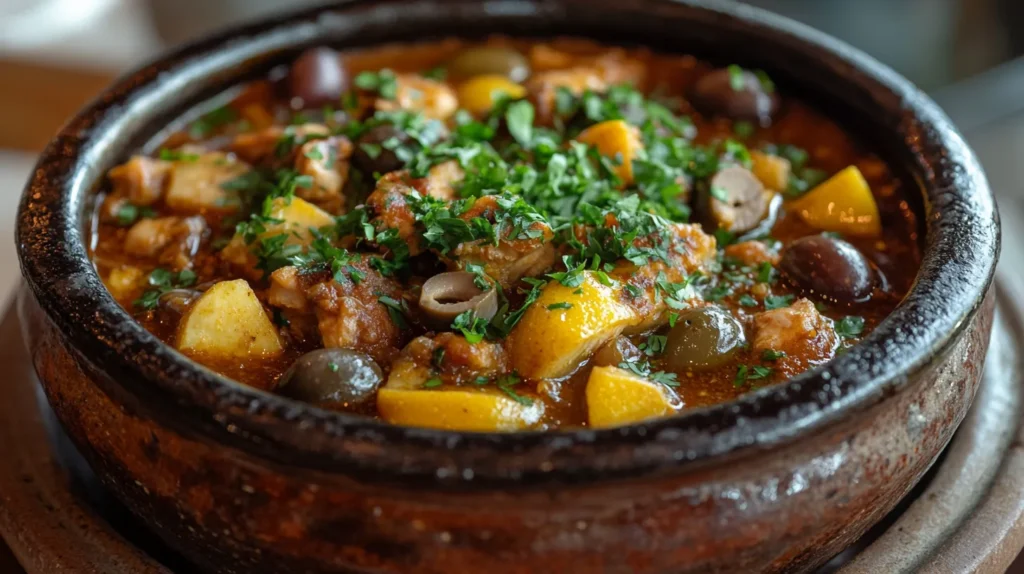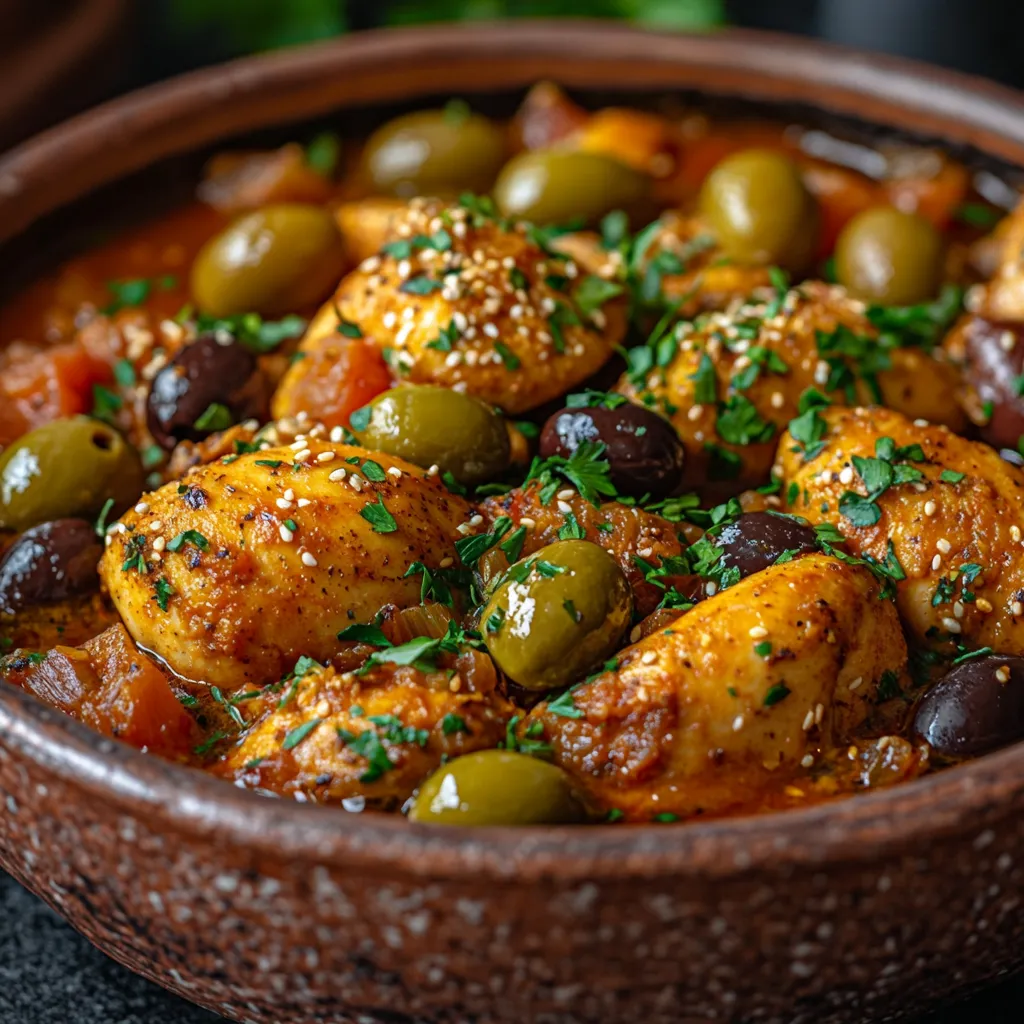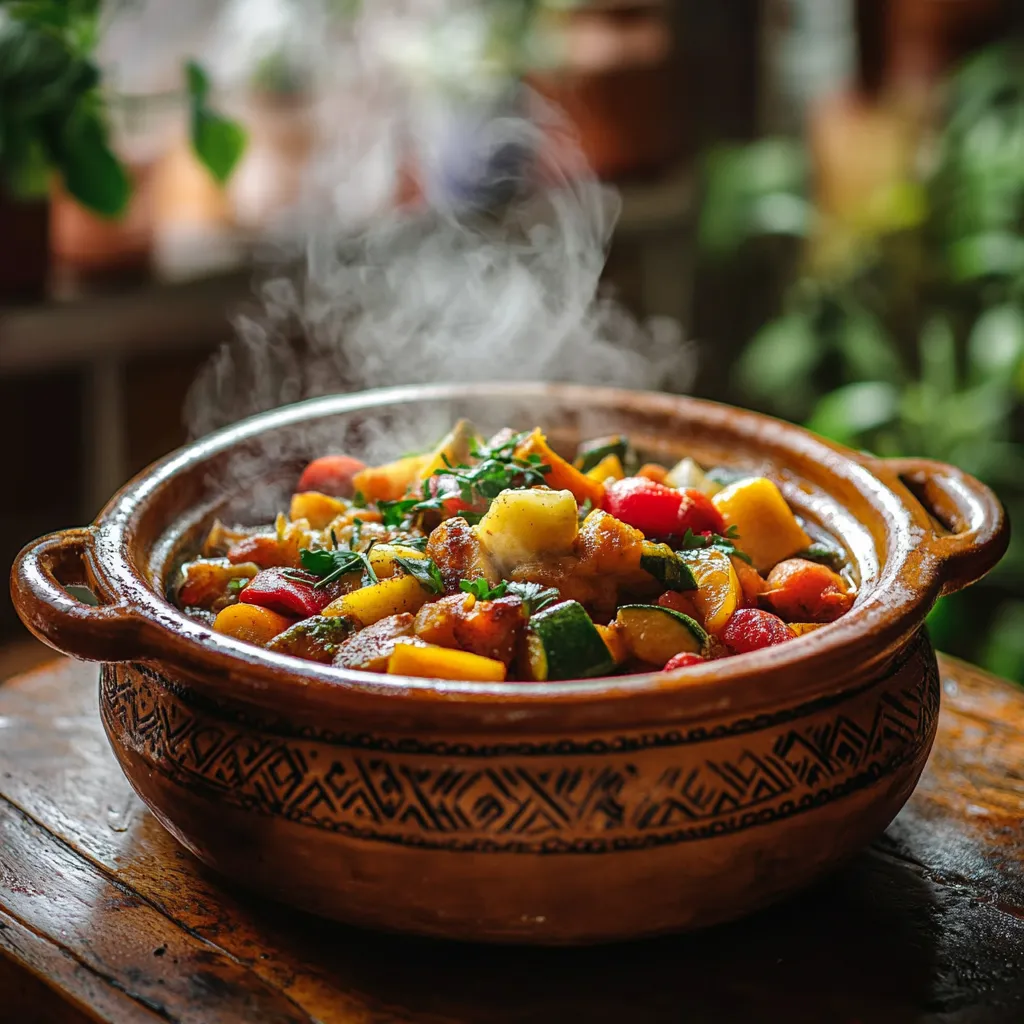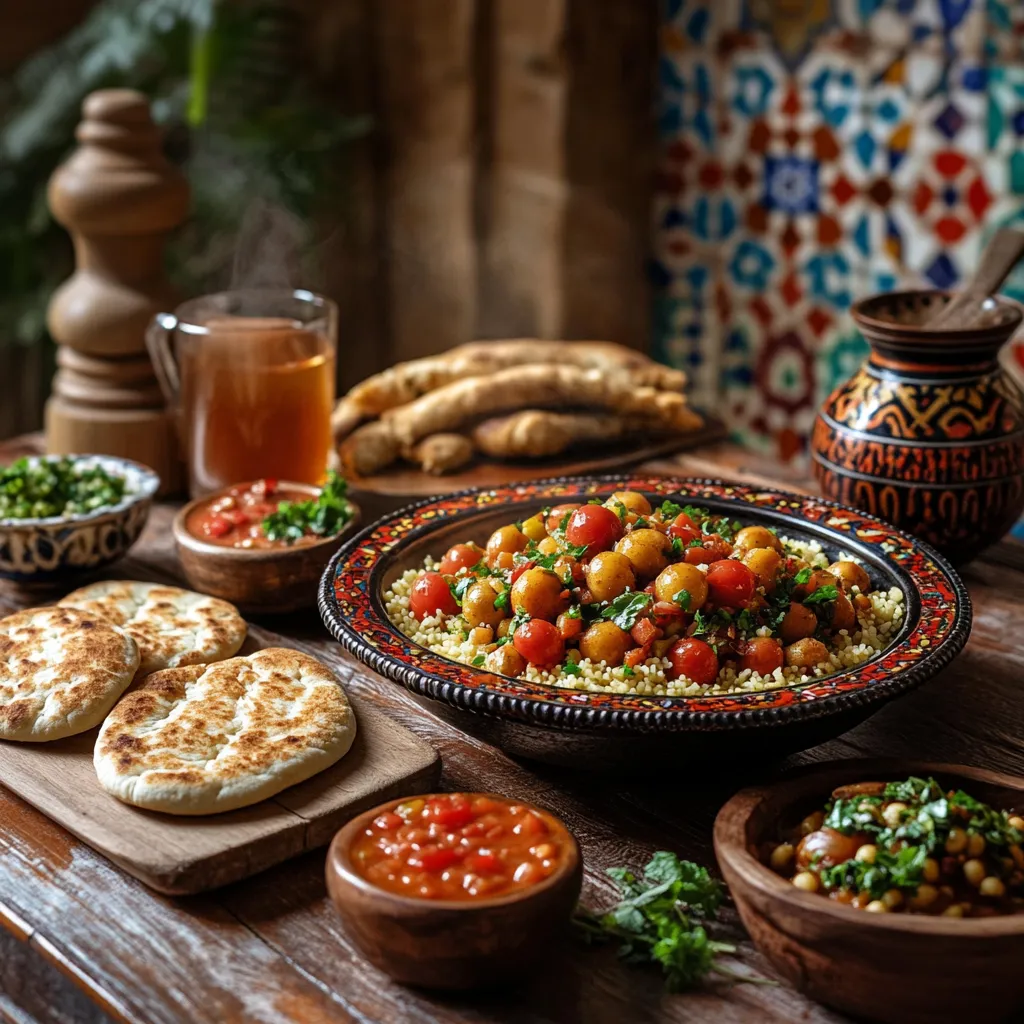The Best Fluffy Pancakes recipe you will fall in love with. Full of tips and tricks to help you make the best pancakes.

Moroccan Tagine isn’t just a meal—it’s a warm, fragrant journey through the heart of North African cuisine. In this article, we’ll explore everything you need to know about this comforting dish, from the different types of tagine to the traditional cooking methods and ingredients that give it its signature flavor. Whether you’re a beginner or already love experimenting with slow-cooked Moroccan meals, you’ll find tips, tricks, and recipes to help you cook a flavorful tagine at home.
We’ll dive into the cultural roots of this dish, the essential spices like Ras el Hanout, and even what to serve on the side. Plus, you’ll discover the best cooking pots to use and how to choose high-quality ingredients like preserved lemons and Moroccan olives. Ready to spice things up in your kitchen? Let’s get into it!
Table of Contents
Part 1: What Is Moroccan Tagine?

A Look at Traditional Moroccan Cooking
At its core, Moroccan Tagine is a savory stew slowly cooked with meat, vegetables, and spices in a uniquely shaped clay pot—also called a tagine. This style of cooking is deeply rooted in Moroccan culture, especially among Berber communities. Over time, the dish has become a symbol of traditional Moroccan food, loved for its tender textures and bold, layered flavors.
Tagine dishes often combine sweet and savory elements. Think of tender lamb paired with sweet prunes or chicken cooked with preserved lemon and olives. These combinations, though simple, are elevated by the careful use of aromatic spices like ginger, cumin, turmeric, and cinnamon. The result? A hearty meal that’s as comforting as it is exotic.
Thanks to its versatility, tagine has made its way into kitchens around the world. Whether you’re cooking for a family dinner or hosting guests, it brings a rich depth of flavor that’s hard to beat.
The Tagine Pot: More Than Just a Dish
The tagine pot is just as important as the recipe. Traditionally made from clay or ceramic, it has a cone-shaped lid that helps steam circulate during cooking. This slow, moist heat keeps the meat juicy and the vegetables tender, all while thickening the sauce into a rich, flavorful base.
Don’t have a clay tagine? No worries—you can still make a delicious Moroccan Tagine in a Dutch oven or heavy-bottomed pot. The key is slow cooking over low heat, allowing time for all those magical flavors to develop.
Part 2: Popular Types of Moroccan Tagine
Chicken Tagine with Lemon and Olives
One of the most well-loved versions of Moroccan Tagine is the zesty chicken tagine with preserved lemon and olives. It’s light, flavorful, and incredibly aromatic. The mix of garlic, ginger, saffron, and preserved lemon gives it that classic Moroccan depth, while green or purple olives bring in a bit of salty tang. It’s not just delicious—it’s comforting in every bite.
For a step-by-step version of this dish, you can check out this Moroccan Chicken Tagine recipe that breaks it down beautifully.
This dish is often served during family gatherings or holidays. What makes it shine is how the acidity from the lemon balances the richness of the chicken and olive oil. Oh, and don’t forget to scoop up that sauce with crusty Moroccan bread!
Lamb Tagine with Prunes and Almonds
If you’re in the mood for something a bit richer, try the lamb tagine with prunes and almonds. This combo brings together sweet and savory in the most Moroccan way. The lamb is slow-cooked until melt-in-your-mouth tender, while prunes add natural sweetness and toasted almonds give it a lovely crunch.
This Beef Tagine Moroccan recipe offers a similar preparation, and you can easily swap beef for lamb if desired.
This dish is ideal for special occasions—it feels fancy without being fussy. Served with fluffy couscous or warm khobz bread, it’s a complete and satisfying meal.
Vegetarian and Vegan Tagine Options
Vegetarian? No problem. Vegetable tagines are just as traditional. They typically include a rainbow of vegetables like carrots, zucchini, potatoes, and chickpeas, all simmered in a tomato-based broth rich with Moroccan spices. It’s hearty, healthy, and totally meat-free.
For a complete pairing, try serving it with this Easy Moroccan Couscous to soak up every drop of that flavorful sauce.
Part 3: Key Ingredients in Moroccan Tagine
Spices That Define the Flavor
What makes a Moroccan Tagine stand out is its vibrant, earthy blend of spices. These aren’t just seasonings—they’re the soul of the dish. The most common tagine spices include:
- Turmeric: Adds a warm, golden hue
- Cumin: Earthy and slightly smoky
- Cinnamon: Often used in lamb or sweet-savory dishes
- Ginger and Paprika: Bring warmth and depth
- Ras el Hanout: A signature Moroccan blend that might include over a dozen spices
These flavors create the unique taste of Moroccan cuisine—warm, fragrant, and comforting. Using quality spices is key. Freshly ground is best, but pre-ground mixes work well in a pinch.
Preserved Lemons, Olives, and Saffron
A few non-negotiable ingredients give Moroccan Tagine its authentic identity. Preserved lemons, often found floating in the chicken version, offer a tangy burst that no fresh lemon can match. They’re pickled in salt and lemon juice, adding a distinct punch to the sauce.
Then there are Moroccan olives, especially purple or green ones, which infuse the dish with a savory, briny depth.
And let’s not forget saffron. This pricey spice adds subtle floral notes and a stunning golden color. Just a few strands go a long way, especially when bloomed in warm water before adding it to the pot.
To discover another variation using these ingredients, the Moroccan Tagine is a great reference.
Part 4: How to Cook Moroccan Tagine the Traditional Way
Using a Clay Tagine on the Stove
Cooking Moroccan Tagine the traditional way means using a clay or ceramic tagine pot. This iconic cookware isn’t just for show—it’s designed to trap steam and circulate it gently, keeping everything tender and juicy.
To start, layer the base with sliced onions and a drizzle of olive oil. Place your marinated meat (like chicken or lamb) in the center, then arrange your vegetables around it. Sprinkle your favorite Moroccan spices, toss in some preserved lemon, olives, and pour a little water to kick-start the steam.
Here’s the trick: keep your heat low and steady. Traditional Moroccan homes often use a heat diffuser to avoid cracking the clay. Let it simmer gently for 1.5 to 2 hours, occasionally peeking to make sure there’s still some moisture. Don’t rush—it’s all about the slow build of flavor.
Slow Cooking for Rich, Deep Flavors
One reason Moroccan Tagine is so irresistible is that slow cooking allows every spice and ingredient to shine. Over time, the juices mingle, the meat softens, and the sauce thickens into pure magic. It’s a cooking process that rewards patience.
While a tagine pot is ideal, a heavy Dutch oven or a slow cooker also works. You might lose some of that traditional aroma from the clay, but the taste? Still heavenly.
The key is low and slow—no shortcuts. When done right, the meat practically falls apart, and every bite is rich with bold Moroccan flavor.
Part 5: Easy Moroccan Tagine for Beginners

Step-by-Step Instructions for Moroccan Tagine
If you’re new to Moroccan cuisine, don’t worry—Moroccan Tagine is easier than it sounds. Here’s a basic chicken tagine recipe to get you started.
Ingredients:
- 1 whole chicken (cut into pieces)
- 1 large onion (chopped)
- 3 cloves garlic (minced)
- 1 tsp turmeric
- 1 tsp ground ginger
- 1 tsp salt
- ½ tsp black pepper
- 1 tsp paprika
- ½ preserved lemon (chopped)
- A handful of green or purple olives
- ¼ cup olive oil
- 2–3 potatoes (peeled and cut)
- ½ cup water
Instructions:
- Mix chicken, onion, garlic, spices, and olive oil in a bowl. Let it marinate for at least 30 minutes.
- In a tagine or Dutch oven, add onions at the base, followed by chicken and potatoes.
- Scatter olives and preserved lemon on top.
- Pour in the water, cover, and cook on low heat for 90–120 minutes.
- Check occasionally and add a bit more water if needed.
- Once the chicken is tender and the sauce thickens, remove from heat and let rest for 10 minutes before serving.
This simple recipe captures the essence of traditional Moroccan home cooking. The preserved lemon and olives give it that signature tangy-salty combo, and the potatoes soak up all the flavor.
Common Mistakes to Avoid When Cooking Moroccan Tagine
First mistake? High heat. Don’t do it. It can cause the tagine pot to crack or dry out the dish too fast. Second, don’t overload your spices. A balanced mix creates harmony; too much can overpower the tagine’s natural richness.
Also, avoid skipping the marination step. Letting the meat soak in those spices for a while makes a huge difference in flavor.
For more delicious recipes, check out other Moroccan dishes on YourRecepes.com.
Part 6: Tagine Cooking Methods – Pot vs. Tagine vs. Slow Cooker
Pros and Cons of Each Cooking Method for Moroccan Tagine
There’s more than one way to make a tasty Moroccan Tagine. While the traditional clay tagine pot is iconic, it’s not the only option—and each method has its own perks and quirks.
Clay Tagine: This is the real deal. Cooking in a clay tagine gives you that earthy aroma and keeps moisture locked in. But it needs low, steady heat and a diffuser if you’re cooking on a stovetop. Plus, it’s a bit fragile.
Dutch Oven: This is a popular substitute. It’s sturdy, retains heat well, and is easy to use. The flavors are still rich, and you won’t need to babysit it as much as a clay pot.
Slow Cooker: Talk about convenience! If you’re busy but still want the deep, layered flavors of Moroccan Tagine, a slow cooker is your friend. Just toss everything in and let it go for a few hours. However, you might miss that signature thickened sauce unless you reduce it at the end.
How to Get the Best Results When Cooking Moroccan Tagine
No matter the method, the goal is the same—tender meat, infused spices, and a thick, savory sauce. To get the best results:
- Always cook low and slow
- Let spices bloom in oil first
- Don’t skip preserved lemons or olives—they define the Moroccan Tagine taste
- Use quality saffron or Ras el Hanout for depth
Whichever pot you pick, patience and fresh ingredients make all the difference.
Part 7: What to Serve with Moroccan Tagine

Traditional Sides: Bread, Couscous, and Salads
Serving Moroccan Tagine is about more than just the stew—it’s about the full experience. Traditionally, tagine is eaten straight from the pot, scooped up with khobz, a thick, crusty Moroccan bread. This bread is perfect for soaking up every drop of that flavorful sauce.
Another classic pairing? Couscous. Though not always served with tagine in Morocco, it’s become a beloved combo worldwide. Light, fluffy couscous complements the rich, saucy tagine beautifully, especially when mixed with raisins or almonds.
You can also add light sides like tomato and cucumber salad, marinated carrots, or zaalouk (a smoky eggplant dip). These fresh options balance out the bold spices in the main dish.
If you’re curious, this Easy Moroccan Couscous recipe makes a wonderful side for any tagine.
Refreshing Drinks to Pair With Your Meal
Tagine dishes are warm and spice-forward, so pairing them with the right drink helps round out the meal. Mint tea is the most popular choice—it’s sweet, cooling, and aids digestion.
You could also go for lemon water, pomegranate juice, or even a citrusy mocktail. These help cleanse your palate between bites and enhance the Moroccan Tagine flavors.
Want to complete your Moroccan feast? Just remember—keep it fresh, balanced, and full of flavor.
Part 8: Tips to Make Your Moroccan Tagine More Flavorful
Balancing Sweet and Savory in Moroccan Tagine
One of the magical things about Moroccan Tagine is how it blends sweet and savory in perfect harmony. But getting the balance right takes a bit of care. If you’re cooking with sweet ingredients like prunes, dates, or apricots, it helps to pair them with stronger spices like cumin or ginger to keep the flavor grounded.
Adding a small pinch of cinnamon can bring a warm sweetness, while preserved lemons and olives offer the salty punch that rounds it all out. The goal? Bold flavor without one note taking over.
Marinating and Layering Ingredients for More Depth
If you really want your Moroccan Tagine to sing, start with a good marinade. Let the meat rest with spices, olive oil, garlic, and herbs for at least an hour—or overnight if you can.
Layering is also key. Place onions at the bottom, then meat, then veggies. This order lets the juices flow down naturally, creating a thick, rich sauce at the base. Don’t rush it—flavor takes time to build.
Part 9: Health Benefits of Eating Moroccan Tagine
Nutritious Ingredients and Spices in Moroccan Tagine
Aside from tasting amazing, Moroccan Tagine is surprisingly healthy. It’s often made with lean proteins like chicken or fish, and loaded with vegetables such as carrots, potatoes, and zucchini. Even the spices pack health perks—turmeric fights inflammation, while garlic and ginger help support immunity.
Not to mention, there’s usually very little added fat. Most recipes rely on olive oil, which is a heart-friendly choice. Plus, slow cooking means you don’t lose nutrients like you would with high-heat frying or grilling.
Low-Fat, High-Flavor Meals for Everyday Eating
Tagines prove that food can be both flavorful and good for you. By skipping cream and butter, and embracing natural ingredients, this dish stays light but deeply satisfying. And because Moroccan Tagine is so filling, you’re less likely to overeat—which makes it great for balanced eating.
So, whether you’re cutting calories or just want to eat cleaner, tagine is a delicious way to stay on track without giving up flavor.
FAQs – People Also Ask
hat is the difference between a tagine and a stew?
While both tagines and stews are slow-cooked dishes, a Moroccan Tagine is traditionally cooked in a cone-shaped clay pot that recirculates moisture, creating deep flavor with minimal water. Regular stews are often made in metal pots and tend to be more liquid-heavy.
Can you cook tagine without a tagine pot?
Absolutely. While a traditional tagine pot enhances flavor and presentation, you can still make a delicious Moroccan Tagine in a Dutch oven or even a slow cooker. Just be sure to keep the heat low and let the dish simmer gently to develop that rich taste.
What does a Moroccan tagine taste like?
A good Moroccan Tagine is a perfect balance of warm spices, tender meat or veggies, and a rich, slightly sweet and tangy sauce. Ingredients like cinnamon, saffron, preserved lemon, and olives create a flavor that’s bold, aromatic, and unforgettable.
How do you clean a clay tagine pot?
To clean a clay tagine, use warm water and a soft sponge—no soap, especially for unglazed tagines, as it can seep into the clay. Let it air dry completely before storing it. Avoid dishwashers or soaking for long periods.



